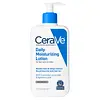Laboratoires Noreva Aquareva Legere Moisturizing Cream 24H Versus CeraVe Daily Moisturizing Lotion Normal To Dry Skin
What's inside
What's inside
 Key Ingredients
Key Ingredients

 Benefits
Benefits

 Concerns
Concerns

 Ingredients Side-by-side
Ingredients Side-by-side

Water
Skin ConditioningGlycerin
HumectantEthylhexyl Palmitate
EmollientSesamum Indicum Seed Oil
EmollientOlive Oil Decyl Esters
Coconut Alkanes
EmollientGlyceryl Stearate Citrate
EmollientCetyl Alcohol
EmollientJojoba Esters
EmollientCoco-Caprylate/Caprate
EmollientSqualene
EmollientHelianthus Annuus Seed Oil
EmollientSodium Hyaluronate
HumectantMyristyl Malate Phosphonic Acid
Skin ConditioningPolyglyceryl-3 Stearate
EmulsifyingPentaerythrityl Distearate
EmulsifyingParfum
MaskingSodium Acrylates Copolymer
Methylpropanediol
SolventPropanediol
SolventHydrogenated Lecithin
EmulsifyingEthylhexylglycerin
Skin ConditioningCaprylhydroxamic Acid
Tocopherol
AntioxidantSorbitan Oleate
EmulsifyingAlcohol
AntimicrobialSorbitan Laurate
EmulsifyingSodium Hydroxide
BufferingChlorphenesin
AntimicrobialDisodium EDTA
Water, Glycerin, Ethylhexyl Palmitate, Sesamum Indicum Seed Oil, Olive Oil Decyl Esters, Coconut Alkanes, Glyceryl Stearate Citrate, Cetyl Alcohol, Jojoba Esters, Coco-Caprylate/Caprate, Squalene, Helianthus Annuus Seed Oil, Sodium Hyaluronate, Myristyl Malate Phosphonic Acid, Polyglyceryl-3 Stearate, Pentaerythrityl Distearate, Parfum, Sodium Acrylates Copolymer, Methylpropanediol, Propanediol, Hydrogenated Lecithin, Ethylhexylglycerin, Caprylhydroxamic Acid, Tocopherol, Sorbitan Oleate, Alcohol, Sorbitan Laurate, Sodium Hydroxide, Chlorphenesin, Disodium EDTA
Water
Skin ConditioningGlycerin
HumectantCaprylic/Capric Triglyceride
MaskingCetearyl Alcohol
EmollientCetyl Alcohol
EmollientPotassium Phosphate
BufferingCeramide NP
Skin ConditioningCeramide AP
Skin ConditioningCeramide EOP
Skin ConditioningCarbomer
Emulsion StabilisingDimethicone
EmollientCeteareth-20
CleansingBehentrimonium Methosulfate
Methylparaben
PreservativeSodium Lauroyl Lactylate
EmulsifyingCholesterol
EmollientDisodium EDTA
Dipotassium Phosphate
BufferingPropylparaben
PreservativeHydrolyzed Hyaluronic Acid
HumectantPhytosphingosine
Skin ConditioningXanthan Gum
EmulsifyingPolysorbate 20
EmulsifyingPolyglyceryl-3 Diisostearate
EmulsifyingWater, Glycerin, Caprylic/Capric Triglyceride, Cetearyl Alcohol, Cetyl Alcohol, Potassium Phosphate, Ceramide NP, Ceramide AP, Ceramide EOP, Carbomer, Dimethicone, Ceteareth-20, Behentrimonium Methosulfate, Methylparaben, Sodium Lauroyl Lactylate, Cholesterol, Disodium EDTA, Dipotassium Phosphate, Propylparaben, Hydrolyzed Hyaluronic Acid, Phytosphingosine, Xanthan Gum, Polysorbate 20, Polyglyceryl-3 Diisostearate
 Reviews
Reviews

Ingredients Explained
These ingredients are found in both products.
Ingredients higher up in an ingredient list are typically present in a larger amount.
Cetyl Alcohol is a fatty alcohol. Fatty Alcohols are most often used as an emollient or to thicken a product.
Its main roles are:
Though it has "alcohol" in the name, it is not related to denatured alcohol or ethyl alcohol.
The FDA allows products labeled "alcohol-free" to have fatty alcohols.
Learn more about Cetyl AlcoholDisodium EDTA plays a role in making products more stable by aiding other preservatives.
It is a chelating agent, meaning it neutralizes metal ions that may be found in a product.
Disodium EDTA is a salt of edetic acid and is found to be safe in cosmetic ingredients.
Learn more about Disodium EDTAGlycerin is already naturally found in your skin. It helps moisturize and protect your skin.
A study from 2016 found glycerin to be more effective as a humectant than AHAs and hyaluronic acid.
As a humectant, it helps the skin stay hydrated by pulling moisture to your skin. The low molecular weight of glycerin allows it to pull moisture into the deeper layers of your skin.
Hydrated skin improves your skin barrier; Your skin barrier helps protect against irritants and bacteria.
Glycerin has also been found to have antimicrobial and antiviral properties. Due to these properties, glycerin is often used in wound and burn treatments.
In cosmetics, glycerin is usually derived from plants such as soybean or palm. However, it can also be sourced from animals, such as tallow or animal fat.
This ingredient is organic, colorless, odorless, and non-toxic.
Glycerin is the name for this ingredient in American English. British English uses Glycerol/Glycerine.
Learn more about GlycerinWater. It's the most common cosmetic ingredient of all. You'll usually see it at the top of ingredient lists, meaning that it makes up the largest part of the product.
So why is it so popular? Water most often acts as a solvent - this means that it helps dissolve other ingredients into the formulation.
You'll also recognize water as that liquid we all need to stay alive. If you see this, drink a glass of water. Stay hydrated!
Learn more about Water